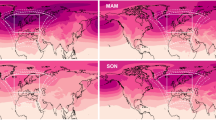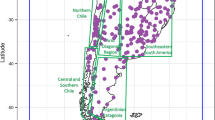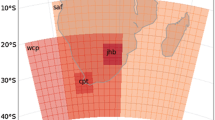Abstract
The aim of the study is to compare the performance of the two classification methods, based on the atmospheric circulation types over the Pannonian basin in Central Europe. Moreover, relationships including seasonal occurrences and correlation coefficients, as well as comparative diagrams of the seasonal occurrences of the circulation types of the two classification systems are presented. When comparing of the automated (objective) and empirical (subjective) classification methods, it was found that the frequency of the empirical anticyclonic (cyclonic) types is much higher (lower) than that of the automated anticyclonic (cyclonic) types both on an annual and seasonal basis. The highest and statistically significant correlations between the circulation types of the two classification systems, as well as those between the cumulated seasonal anticyclonic and cyclonic types occur in winter for both classifications, since the weather-influencing effect of the atmospheric circulation in this season is the most prevalent. Precipitation amounts in Budapest display a decreasing trend in accordance with the decrease in the occurrence of the automated cyclonic types. In contrast, the occurrence of the empirical cyclonic types displays an increasing trend. There occur types in a given classification that are usually accompanied by high ratios of certain types in the other classification.




Similar content being viewed by others
References
Anagnostopoulou C, Tolika K, Maheras P (2009) Classification of circulation types: a new flexible automated approach applicable of NCEP and GCM datasets. Theor Appl Climatol 96:3–15
Bárdossy A, Stehlík J, Caspary HJ (2002) Automated objective classification of daily circulation patterns for precipitation and temperature downscaling based on optimized fuzzy rules. Clim Res 23:11–22
Bartholy J, Pongrácz R, Gy Gelybó (2009) Climate signals of the North Atlantic oscillation detected in the Carpathian basin. Appl Ecol Env Res 7:229–240
Bartoszek K (2017) The main characteristics of atmospheric circulation over east—central Europe from 1871 to 2010. Meteorol Atmos Phys 129:113–129
Bartzokas A, Metaxas DA (1996) Northern Hemisphere gross circulation types. Climatic change and temperature distribution. Meteorol Zeitschrift 5:99–109
Baur F, Hess P, Nagel H (1944) Kalendar der Groswetterlagen Europas 1881–1939. (Calendar of the large-scale weather situations for Europe.) Bad Homburg, Germany (in German)
Casado MJ, Pastor MA, Doblas-Reyes FJ (2009) Euro-Atlantic circulation types and modes of variability in winter. Theor Appl Climatol 96:17–29
Demuzere M, Kassomenos P, Philipp A (2011) The COST733 circulation type classification software: an example for surface ozone concentrations in Central Europe. Theor Appl Climatol 105:143–166
Frakes B, Yarnal B (1997) A procedure for blending manual and correlation-based synoptic classifications. Int J Climatol 17:1381–1396
Gerstengarbe FW, Werner PC, Rüge U (1999) Katalog der Großwetterlagen Europas (1881–1998) nach Paul Hess und Helmuth Brezowsky. [Catalog of the large-scale weather situations for Europe (1881–1998) on Paul Hess and Helmuth Brezowsky.] Potsdam, Offenbach a.M. (Germany). http://www.pikpotsdam.de/~uwerner/gwl/welcome.htm (in German)
Girs AA (1948) Some aspects concerning basic forms of atmospheric circulation. Meteorol Gidrol 3:9–11 (in Russian)
Hess P, Brezowsky H (1952) Katalog der Großwetterlagen Europas. Ber Dt Wetterd in der US-Zone 33, Bad Kissingen, Germany
Hewitson BC, Crane RG (2002) Self-organizing maps: applications to synoptic climatology. Clim Res 22:13–26
Huth R (2000) A circulation classification scheme applicable in GCM studies. Theor Appl Climatol 67:1–18
Huth R, Beck C, Philipp A, Demuzere M, Ustrnul Y, Cahynová M, Kyselý J, Tveito OE (2008) Classifications of atmospheric circulation patterns: recent advances and applications. Ann NY Acad Sci 1146:105–152
Jones PD, Hulme M, Brifia KR (1993) A comparison of Lamb circulation types with an objective classification scheme. Int J Climatol 13:655–663
Kalkstein LS, Corrigan P (1986) A synoptic climatological approach for geographical analysis: assessment of sulfur dioxide concentrations. Ann Assoc Am Geogr 76:381–395
Kalnay E, Kanamitsu M, Kisdér R, Collins W, Deaven D, Gandin L, Iredell M, Saha S, White G, Woollen J, Zhu Y, Chelliah M, Ebisuzaki W, Higgins W, Janowiak J, Mo KC, Ropelewski C, Wang J, Leetmaa A, Reynolds R, Jenne R, Joseph D (1996) The NCEP/NCAR 40-year reanalysis project. Bull Am Met Soc 77:437–471
Károssy C (2016) A Kárpát-medence Péczely-féle makroszinoptikus helyzeteinek a katalógusa (1881–2015). (Catalog of the Péczely’s macrosynoptic types for the Carpathian Basin.) OSKAR, Szombathely (in Hungarian)
Kassomenos P, Flocas HA, Lykoudis S, Petrakis M (1998) Analysis of mesoscale patterns in relation to synoptic conditions over an urban Mediterranean basin. Theor Appl Climatol 59:215–229
Kassomenos P, Gryparis A, Samoli E, Katsouyanni K, Lykoudis S, Flocas HA (2001) Atmospheric circulation types and daily mortality in Athens, Greece. Environ Health Perspect 109:591–596
Kassomenos P, Sindosi O, Lolis C, Chaloulakou A (2003) On the relation between seasonal synoptic circulation types and spatial air quality characteristics in Athens, Greece. J Air Waste Manag Assoc 53:309–324
Kassomenos PA, Gryparis A, Katsouyanni K (2007) On the association between daily mortality and air mass types in Athens, Greece during winter and summer. Int J Biometeorol 51:315–322
Klicász Sz (1990) Görögország makroszinoptikus helyzetei. (Macrosynoptic types of Greece.) PhD Dissertation, University of Szeged, Szeged, p 85 (in Hungarian)
Kyselý J, Huth R (2006) Changes in atmospheric circulation over Europe detected by objective and subjective methods. Theor Appl Climatol 85:13–36
Lamb HH (1972) British Isles weather types and a register of daily sequence of circulation patterns, 1861–1971. Geophysical Memoir, vol 116. HMSO, London, p 85
Maheras P (1983) Climatologie de la Mer Egée et de ses Marges Continentales. Etude de Climatologie Descriptive et de Climatologie Dynamique. Thèse d’Etat, Atelier de Reproduction de Lille III, Lille, p 787
Maheras P (1988) The synoptic weather types and objective delimitation of the winter period in Greece. Weather 43:40–45
Maheras P, Patrikas I, Karacostas Th, Anagnostopoulou Ch (2000a) Automatic classification of circulation types in Greece. Methodology, description, frequency, variability and trend analysis. Theor Appl Climatol 67:205–223
Maheras P, Patrikas I, Anagnostopoulou C (2000b) An objective classification of circulation types in Greece. In: Proceedings of the 5th Hellenic scientific conference in meteorology, climatology and atmospheric physics, 28–30 September 2000, Thessaloniki, National Hellenic Research Foundation, pp 25–33
Makra L (2005) Relation of pollutant concentrations to the Peczely’s large scale weather situations in Szeged, Southern Hungary. Epidemiology 16:S63–S63
Makra L (2006) Comparison of objective air-mass types and the Peczely weather types and their ability of classifying airborne pollen grain concentrations in Szeged, Hungary. Epidemiology 17:S292–S293
Makra L (2012) Különböző taxonok pollenjeinek komplex statisztikai elemzése a meteorológiai elemekkel összefüggésben, különös tekintettel a parlagfű pollenjére. Kézirat (Complex pollen-statistical analysis of various taxa, in association with meteorological parameters, with special interest to the pollen of ragweed.) MTA Doktori Értekezés, Thesis (Doctor of the Hungarian Academy of Sciences), dc_299_11, University of Szeged, Szeged, Hungary (in Hungarian), p 123. OAI identifier: oai:real-d.mtak.hu:513. http://real-d.mtak.hu/513/
Makra L, Mika J, Bartzokas A, Sümeghy Z (2007a) Relationship between the Péczely’s large-scale weather types and air pollution levels in Szeged, Southern Hungary. Fresen Environ Bull 16:660–673
Makra L, Juhász M, Mika J, Bartzokas A, Béczi R, Sümeghy Z (2007b) Relationship between the Péczely’s large-scale weather types and airborne pollen grain concentrations for Szeged, Hungary. Grana 46:43–56
Makra L, Mika J, Bartzokas A, Béczi R, Sümeghy Z (2009) Comparison of objective air-mass types and the Péczely weather types and their ability to classify levels of air pollutants in Szeged, Hungary. In: Makra L, Kambezidis HD (eds) Int J Environ Pollut “Air Pollution” Special Issue 36, pp 81–98
McGregor GR, Bamzelis D (1995) Synoptic typing and its application to the investigation of weather-air pollution relationships, Birmingham, United Kingdom. Theor Appl Climatol 51:223–236
Mika J (2014) Atmosphere as risk and resource: elektronikus jegyzet Geográfus MSc hallgatók számára (Electronic lecture note for MSc students in Geography). Eszterházy Károly Főiskola (Eszterházy Károly College), Eger, p 163
Péczely Gy (1957a) Áramlási viszonyok Magyarországon különböző makroszinoptikus helyzetekben. (Air flow conditions in different macrosynoptic situations in Hungary.) Időjárás 61:408–419 (in Hungarian)
Péczely Gy (1957b) Grosswetterlagen in Ungarn. Kleinere Veröffentlichungen der Zentralanstalt für Meteorologie, Budapest, Ungarn. (Large-scale weather situations in Hungary. Minor publications of the Central Meteorological Institute, Budapest, Hungary.) Series 30, p 86 (in German)
Péczely Gy (1959) Budapest légszennyeződése különböző makroszinoptikus helyzetekben. (Air pollution of Budapest in different macrosynoptic situations.) Időjárás 63:19–27 (in Hungarian)
Péczely Gy (1961) Magyarország makroszinoptikus helyzeteinek éghajlati jellemzése. (Climatic characterization of macrosynoptic situations of Hungary. (A Központi Meteorológiai Intézet Kisebb Kiadványai. (Minor publications of the Central Meteorological Institute, Hungary.) Series 32, p 128, Budapest (in Hungarian)
Péczely Gy (1983) Magyarország makroszinoptikus helyzeteinek katalógusa (1881–1983). (Catalog of the macrosynoptic types of Hungary.) (Az Országos Meteorológiai Szolgálat Kisebb Kiadványai. (Minor publications of the Hungarian Meteorological Service.) Series 53, p 116, Budapest (in Hungarian)
Perry A, Mayes J (1998) The Lamb weather type catalogue. Weather 53:222–229
Philipp A, Bartholy J, Beck C, Erpicum M, Esteban P, Fettweis X, Huth R, James P, Jourdain S, Kreienkamp F, Krennert T, Lykoudis S, Michalides S, Pianko-Kluczynska K, Post P, Rassilla Álvarez D, Schiemann R, Spekat A, Tymvios FS (2010) COST733CAT—a database of weather and circulation type classifications. Phys Chem Earth 35:360–373
Putniković S, Tošić I (2017) Relationship between atmospheric circulation weather types and seasonal precipitation in Serbia. Meteorol Atmos Phys. https://doi.org/10.1007/s00703-017-0524-y
Putniković S, Tošić I, Đurđević V (2016) Circulation weather types and their influence on precipitation in Serbia. Meteorol Atmos Phys 128:649–662
Ramos AM, Sprenger M, Wernli H, Durán-Quesada AM, Lorenzo MN, Gimeno L (2014) A new circulation type classification based upon Lagrangian air trajectories. Front Earth Sci 2(29):1–18
Sheridan SC (2002) The redevelopment of a weather type classification scheme for North America. Int J Climatol 22:51–68
Sindosi OA, Katsoulis BD, Bartzokas A (2003) An objective definition of air mass types affecting Athens, Greece; the corresponding atmospheric pressure patterns and air pollution levels. Environ Technol 24:947–962
Solman SA, Menéndez CG (2003) Weather regimes in the South American sector and neighbouring oceans during winter. Clim Dyn 21:91–104
Spellman G (2017) An assessment of the Jenkinson and Collison synoptic classification to a continental mid-latitude location. Theor Appl Climatol 128:731–744
Stehlík J, Bárdossy A (2003) Statistical comparison of European circulation patterns and development of a continental scale classification. Theor Appl Climatol 76:31–46
Vangengeim GY (1935) Application of synoptic methods to the study and characterization of climate. Gidrometeoizdat, Moscow (in Russian)
Author information
Authors and Affiliations
Corresponding author
Additional information
Responsible Editor: M. Telisman Prtenjak.
Rights and permissions
About this article
Cite this article
Maheras, P., Tolika, K., Tegoulias, I. et al. Comparison of an automated classification system with an empirical classification of circulation patterns over the Pannonian basin, Central Europe. Meteorol Atmos Phys 131, 739–751 (2019). https://doi.org/10.1007/s00703-018-0601-x
Received:
Accepted:
Published:
Issue Date:
DOI: https://doi.org/10.1007/s00703-018-0601-x




